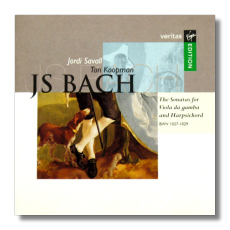
The Internet's Premier Classical Music Source
Related Links
- J.S. Bach Reviews
- Latest Reviews
- More Reviews
-
By Composer
-
Collections
DVD & Blu-ray
Books
Concert Reviews
Articles/Interviews
Software
Audio
Search Amazon
Recommended Links
Site News
 CD Review
CD Review
Johann Sebastian Bach

Sonatas for Viola da Gamba & Harpsichord
- Sonata #1 in G Major, BWV 1027
- Sonata #2 in D Major, BWV 1028
- Sonata #3 in G minor, BWV 1029
Jordi Savall, viola da gamba
Ton Koopman, harpsichord
Virgin Veritas CDM 561291 43:52
Summary for the Busy Executive: Disappointing.
I first encountered the three sonatas on an LP with Bernard Greenhouse on the cello, accompanied by pianist Anthony Makas. It remains not only a favorite recording, but a benchmark for these works. If one can characterize the solo suites for cello as introspective – a kind of inner communing – the accompanied sonatas from the same period (around 1720), while not lacking soulful movements, nevertheless impress me over all as gracious, "social," and witty. The first two sonatas exhibit an older form: four movements (slow, fast, slow, fast), with the slow ones serving mainly as introductions to the quick. For the third sonata, Bach resorts to the "modern" concerto form, which he got from Vivaldi and Corelli, among others, and which he brought to its height: three movements (fast, slow, fast). The movements not only retain their individual identity, but together form an effective whole.
My main problem with this recording comes from the "social" aspect of these works. In effect, they are trio sonatas, with the gamba on one line, and the remaining two lines with the harpsichordist's left and right hands. Indeed, the Sonata in G essentially transcribes an earlier work for two flutes and continuo. To me, this implies a collaboration, as opposed to the solo cello suites' one-man show, but the performers don't seem to be communicating with each other. Each player's driving hell-bent down his private road in his own car. The balance never changes, and the balance seems seriously out of whack – whether due to the performers or to the engineers I can't really say. The gamba is almost always too far forward, with the harpsichordist's right hand coming in a close second and the left hand practically out of it. Indeed, the only thing the left hand contributes is a nasty, dull bass reverberation, sort of like hearing sounds under water. I find the performances leaden, despite the considerable technique of Koopman and Savall. For the most part, they bang and saw away. Very little music is being shaped. They do best with the third sonata, which does manage to show some movement, although compared with Greenhouse and Makas or, on period instruments, Crum and Cummings (Signum SIGCD024), it's more like electricity through a dead frog.
Copyright © 2002, Steve Schwartz


















